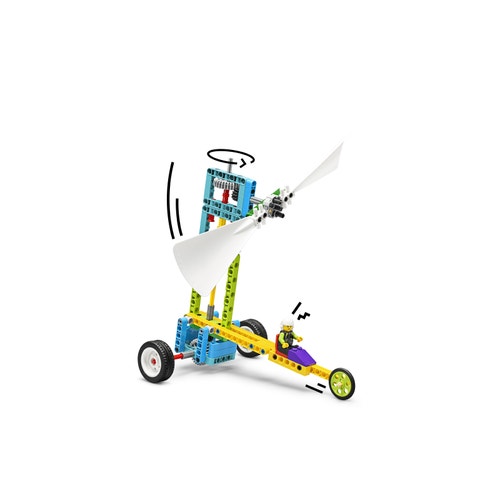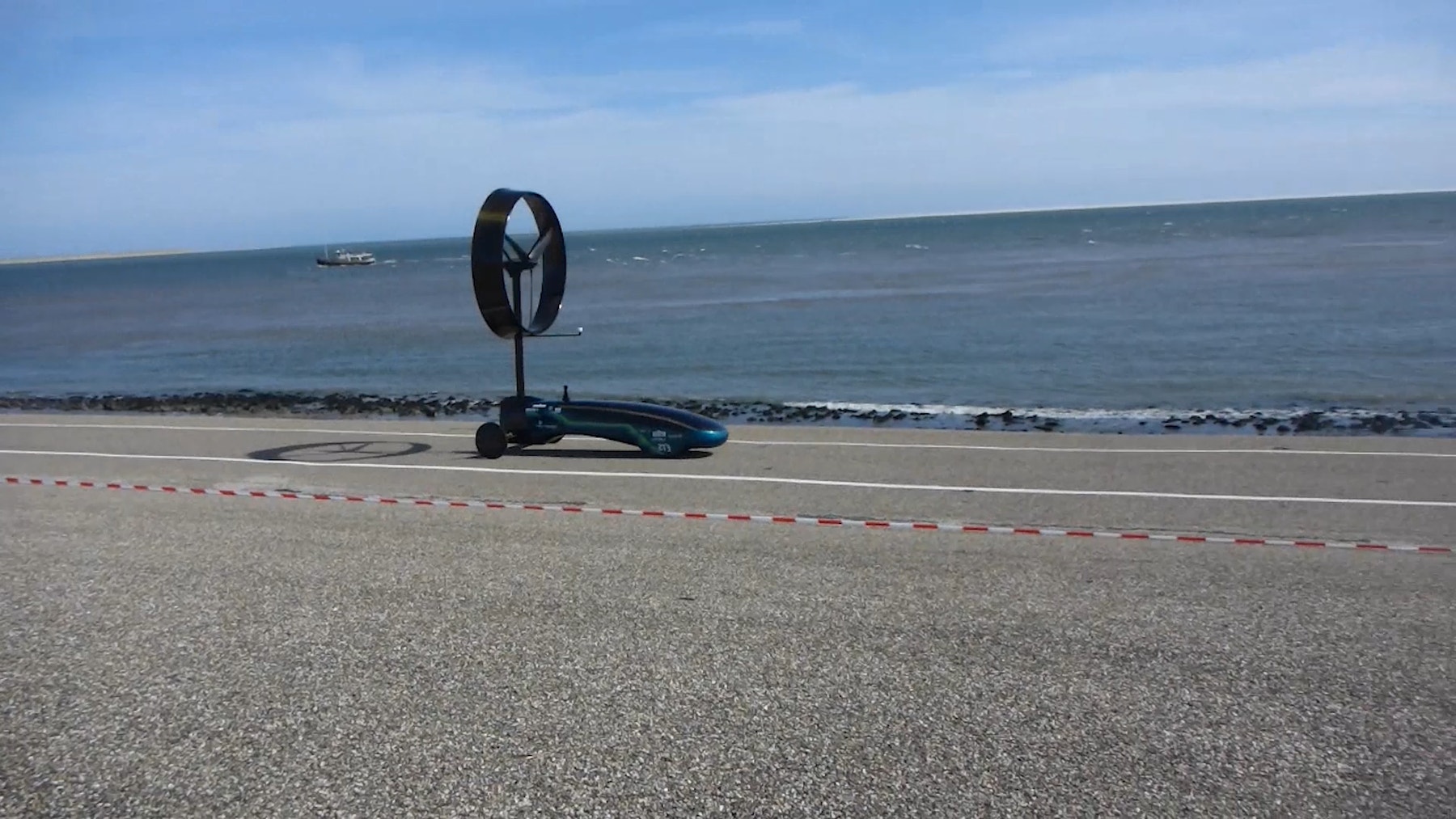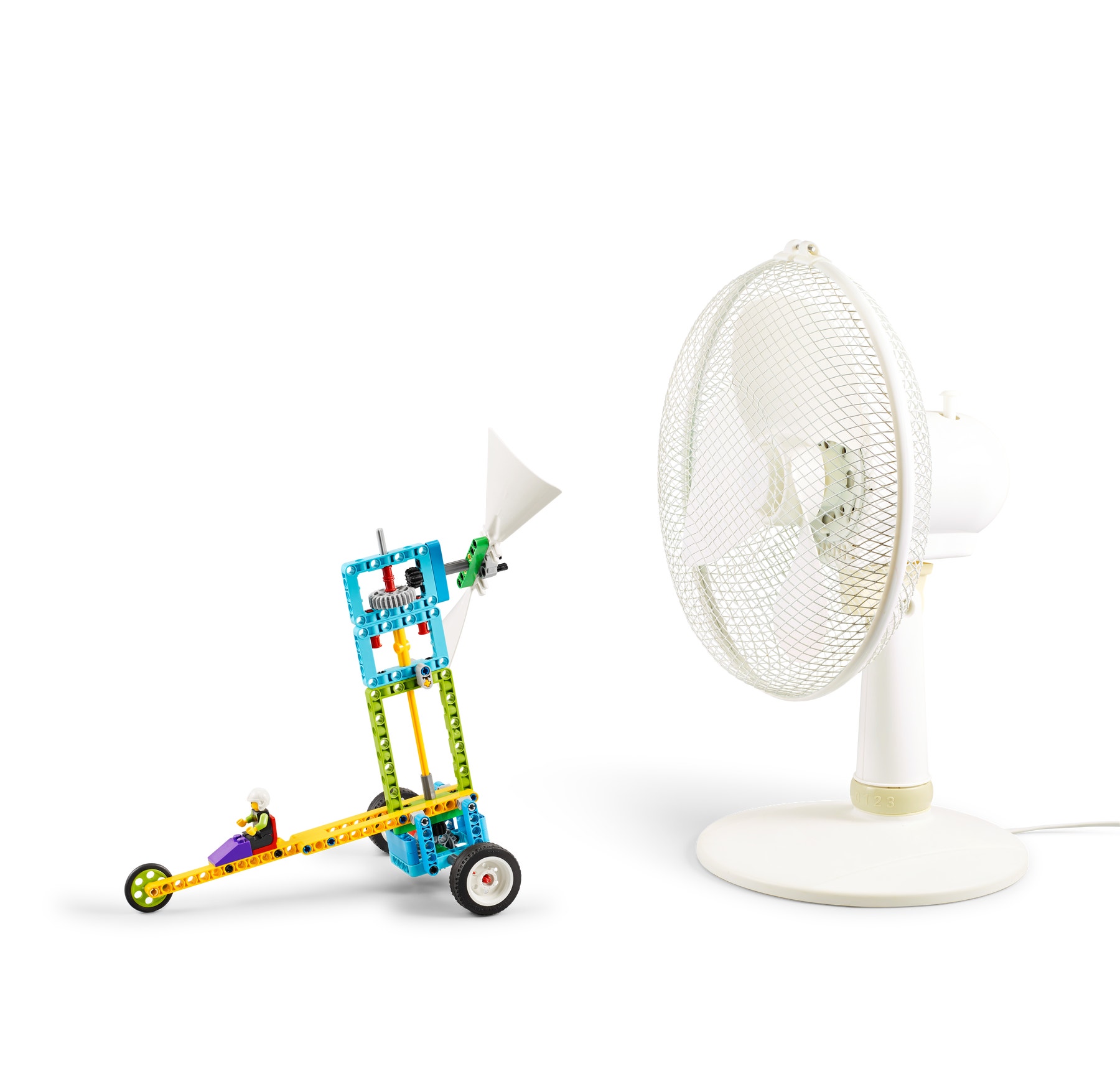Propeller Car
Although a sailboat or land yacht can’t easily sail upwind, it is possible to make it happen with clever engineering. Investigate how mechanical forces can change an object's motion and how these forces can act from a distance.

Prepare
- Review the online pupil material. Use a projector to share this material with your pupils during the lesson.
- Make sure that you have covered Newton’s three laws of motion in an earlier lesson.
- Consider the abilities and backgrounds of all your pupils. Differentiate the lesson to make it accessible to everyone. See the Differentiation section below for suggestions.
- Set up the fans on the floor, allowing at least 3 meters in front of each, so that the propeller cars have room to move. Use a strip of tape to mark a start position in front of each fan (perpendicular to the fan).
Engage
(Whole Class, 5 Minutes)
- Watch the pupil video here or access it via the online pupil material.

- Facilitate a quick discussion about which force makes a propeller car move.
- Ask questions like these:
- What makes a wind turbine move? (Wind, which is generated by differences in atmospheric pressure.)
- Which forces make a wind turbine move? (The shape of the blades affects the force vectors of the wind, which results in a rotational motion.)
- Tell the pupils that they are going to build a propeller car and investigate how wind force can change its motion.
Explore
(Small Groups, 30 Minutes)
- Ask the pupils to work in pairs to build the Propeller Car model. Tell them to take turns, one partner searching for the bricks while the other builds, switching roles after each step has been done.
- You can find building help in the Tips section below.
- Direct the pupils to the three experiments that are found in the pupil material for this lesson. Distribute the Student Worksheets (Teacher Support – Additional Resources).
Experiment 1: Into the Wind
- Ask the pupils to set their propeller cars on the start line, facing towards the fan.
- Tell them to switch the fans on and observe how their cars move.
- Have them record their observations on their Student Worksheets.
Experiment 2: Downwind
- Ask the pupils to switch the position of the propeller so that it is facing backwards, or to flip the gear assembly upside down so that the grey gear is on top.
- Have them switch the fan on to observe what happens to their cars when they are facing forwards and then backwards.
- Have them record their observations on their Student Worksheets.

Experiment 3: More Fan Blades
- Have the pupils add the extra fan blade and run the experiment again. If time permits, have them try these variations:
- Propeller gear module facing up
- Propeller gear module facing down
- Propeller gear module facing backwards
- A 4-bladed propeller
- A 6-bladed propeller (see page 3 of the building instructions book for a hint)

Explain
(Whole Class, 5 Minutes)
- Gather your pupils together to review and discuss their experiments.
- Ask questions like these:
- What could you change to make your car switch from going towards the wind (upwind) to going away from the wind (downwind)? (The gearing, or the direction of the propeller.)
- What causes the propeller car to move upwind (towards the fan)? (The sum of the force vectors acting on the vehicle push it upwind.)
- Can a wind-powered car travel faster than the wind is blowing? (Yes! Some of the cars in the video that we watched at the beginning of class were moving a lot faster than the wind was blowing.)
Elaborate
(Whole Class, 5 Minutes)
- If time permits, explain the forces that are at work (force vectors) in detail.
- Allow time for the pupils to disassemble their models, sort the bricks back into the trays and tidy up their workstations.
Evaluate
(Ongoing Throughout the Lesson)
- Give feedback on each pupil's performance.
- Facilitate self-assessment.
- To simplify the process, you can use the assessment rubrics that have been provided.
Observation Checklist
- Measure your pupils’ proficiency in describing how different forces and mechanisms can change an object's motion.
- Establish a scale that suits your needs. For example:
- Requires additional support
- Can work independently
- Can teach others
Self-Assessment
- Have each pupil choose the brick that they feel best represents their performance.
- Green: With some help, I can describe how an invisible force combined with a gear train can change an object's motion.
- Blue: I can describe how an invisible force combined with a gear train can change an object's motion.
- Purple: I can describe and explain how an invisible force combined with a gear train can change an object's motion.
Peer Feedback
- Encourage your pupils to assess their peers by:
- Using the brick scale above to score each other's performance
- Presenting their ideas and giving constructive feedback

Tips
Model Tips
- Have the groups start testing as soon as they have finished building. They should take turns as they make adjustments to ensure that everyone has a chance to test their models.
- Choose ONE fan speed to use for all the tests. Any speed will do.
- If your fan is too big or too powerful, try moving it farther back from the start line. You can use a piece of furniture to block some of the fan's airflow.
- If your fan is too small, move it closer to the models or try moving the fan by hand, following the models.
Differentiation
Simplify this lesson by:
- Having your pupils try only the base-model variable of having the car move upwind
Increase the difficulty by:
- Challenging the pupils to figure out how to make their cars drive upwind more efficiently
- Asking the pupils to figure out how to replace the fan with a flywheel to make their cars move
Extensions
(Note: This will require additional time.)
To incorporate the development of maths skills, ask your pupils to explore the concept of a ratio and use ratio language to describe the gear ratio relationship between the rate at which the propeller blades turn and the rate at which the wheels turn.
ACMNA173
Recognise and solve problems involving simple ratios
Teacher Support
The pupils will:
- Understand how forces can change an object's motion
- Understand how forces can act from a distance
- Explore the relationship between energy and forces
- LEGO® Education BricQ Motion Prime Sets (one for every two pupils)
- Masking tape
- Medium-sized tabletop electric fans (ideally, one for every ten pupils)
ACSSU155
Energy appears in different forms, including movement (kinetic energy), heat and potential energy, and energy transformations and transfers cause change within systems
ACSIS140
Collaboratively and individually plan and conduct a range of investigation types, including fieldwork and experiments, ensuring safety and ethical guidelines are followed
ACMNA173
Recognise and solve problems involving simple ratios




